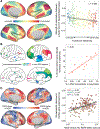Neurodevelopment of the association cortices: Patterns, mechanisms, and implications for psychopathology
- PMID: 34270921
- PMCID: PMC8448958
- DOI: 10.1016/j.neuron.2021.06.016
Neurodevelopment of the association cortices: Patterns, mechanisms, and implications for psychopathology
Abstract
The human brain undergoes a prolonged period of cortical development that spans multiple decades. During childhood and adolescence, cortical development progresses from lower-order, primary and unimodal cortices with sensory and motor functions to higher-order, transmodal association cortices subserving executive, socioemotional, and mentalizing functions. The spatiotemporal patterning of cortical maturation thus proceeds in a hierarchical manner, conforming to an evolutionarily rooted, sensorimotor-to-association axis of cortical organization. This developmental program has been characterized by data derived from multimodal human neuroimaging and is linked to the hierarchical unfolding of plasticity-related neurobiological events. Critically, this developmental program serves to enhance feature variation between lower-order and higher-order regions, thus endowing the brain's association cortices with unique functional properties. However, accumulating evidence suggests that protracted plasticity within late-maturing association cortices, which represents a defining feature of the human developmental program, also confers risk for diverse developmental psychopathologies.
Keywords: MRI; adolescence; association cortex; axis; evolution; gradient; microscale; neurodevelopment; neuroimaging; psychopathology.
Copyright © 2021 Elsevier Inc. All rights reserved.
Conflict of interest statement
Declaration of interests The authors declare no competing interests.
Figures







References
-
- Amlien IK, Fjell AM, Tamnes CK, Grydeland H, Krogsrud SK, Chaplin TA, Rosa MGP, and Walhovd KB (2016). Organizing principles of human cortical development—thickness and area from 4 to 30 years: insights from comparative primate neuroanatomy. Cereb. Cortex 26, 257–267. - PubMed
Publication types
MeSH terms
Grants and funding
- R01 MH111439/MH/NIMH NIH HHS/United States
- R01 NS099348/NS/NINDS NIH HHS/United States
- R01 MH120482/MH/NIMH NIH HHS/United States
- K08 MH120564/MH/NIMH NIH HHS/United States
- RF1 MH116920/MH/NIMH NIH HHS/United States
- R01 MH113550/MH/NIMH NIH HHS/United States
- T32 MH014654/MH/NIMH NIH HHS/United States
- F31 MH123063/MH/NIMH NIH HHS/United States
- P50 MH109429/MH/NIMH NIH HHS/United States
- R01 MH119185/MH/NIMH NIH HHS/United States
- T32 MH019112/MH/NIMH NIH HHS/United States
- R01 MH112847/MH/NIMH NIH HHS/United States
- R01 MH120174/MH/NIMH NIH HHS/United States
- S10 OD023495/OD/NIH HHS/United States
LinkOut - more resources
Full Text Sources
Medical

